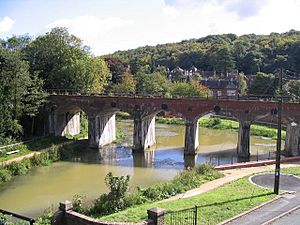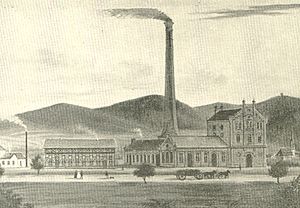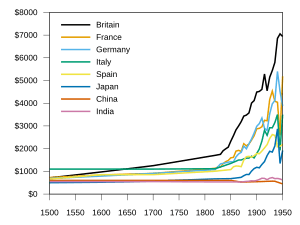Industrialization facts for kids

Industrialization is a big change that happens when countries start using machines to do work. Before this, people did most work by hand. This shift from manual labor to machine work changes society a lot.
During industrialization, many people move from farming to work in factories. These factory jobs are often in towns and pay more money. This process helps countries make things faster and cheaper.
When better technology is used, factories can produce many more goods. This means a single person can help make more products than before.
Industrialization also leads to more specialized jobs. For example, a cobbler used to make an entire shoe by himself. He would finish one pair before starting the next. With industrialization, many people work together to make shoes. One person might only cut the sole. Another person might stitch it on. This is called the division of labour.
The machines needed for factories are very expensive. Because of this, factories are usually owned by wealthy people. They are the ones who can afford to buy all the necessary equipment.
Industrialization first began in England with the Industrial Revolution in the 18th century. From there, it spread to parts of Europe and North America. In the 20th century, industrialization reached most other countries around the world.
Contents
What is Industrialization?
Industrialization is when a country moves from making things by hand to using machines. It's like upgrading from drawing pictures with crayons to using a fancy computer and printer. Machines help make products much faster and in larger amounts. This process changes how people live and work.
From Farms to Factories
Before industrialization, most people worked on farms. They grew food and raised animals. When factories started to appear, they offered new jobs. These jobs often paid better than farm work. So, many families moved from the countryside to towns and cities. They wanted to work in these new factories.
Why Machines are Important
Machines are key to industrialization. They can do tasks much quicker and more accurately than humans. For example, a machine can weave cloth faster than a person using a hand loom. This means more clothes can be made for more people. Using machines also often makes products cheaper to buy.
How Industrialization Changed Work
Industrialization didn't just change where people worked. It also changed how they worked.
Specialized Jobs and Teamwork
Imagine making a car. Before industrialization, one person might build a whole cart. With industrialization, many people work together. One person might only put on the wheels. Another might install the engine. This is called specialization. Each person becomes very good at one small task. This makes the whole process faster and more efficient.
Who Owns the Factories?
Machines and factories cost a lot of money. Because of this, rich people or companies usually own them. They invest their money to build factories and buy machines. Then, they hire many workers to operate the machines and make products. This system helped create many new jobs.
Where and When it Started
Industrialization didn't happen everywhere at once. It started in one place and then spread.
The First Industrial Revolution
The first big wave of industrialization began in England in the 1700s. This period is known as the Industrial Revolution. New inventions like the steam engine and power looms changed everything. They made it possible to build large factories.
Spreading Across the World
After England, industrialization spread to other countries. It reached parts of Europe and North America in the 1800s. In the 1900s, many more countries in Asia, Africa, and South America also started to industrialize. Today, industrialization continues in many developing nations.
Images for kids
See also
 In Spanish: Industrialización para niños
In Spanish: Industrialización para niños







